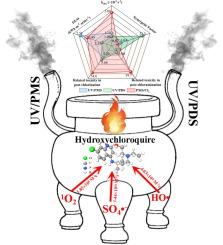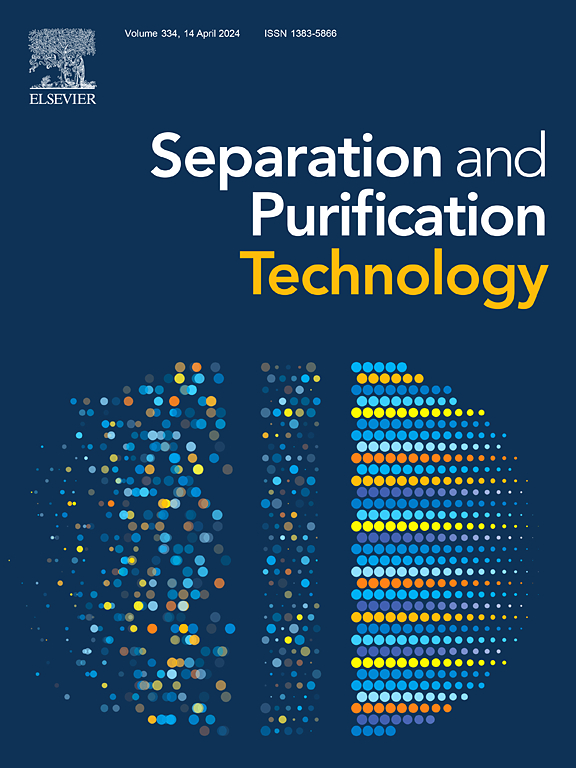A comparative study on the efficient removal of hydroxychloroquine via UV/peroxymonosulfate and UV/peroxydisulfate systems triggered by reactive oxygen species: Process behaviors and the functional relevance of singlet oxygen
IF 8.1
1区 工程技术
Q1 ENGINEERING, CHEMICAL
引用次数: 0
Abstract
The efficient removal of hydroxychloroquine (HCQ) by UV/ peroxymonosulfate (UV/PMS) and UV/peroxydisulfate (UV/PDS) treatments triggered by reactive oxygen species (ROS) was comprehensively compared in terms of process behaviors and the functional relevance of singlet oxygen (1O2). Both UV/PMS and UV/PDS can remove HCQ quickly and the elimination rate followed the trend as UV/PMS > UV/PDS > UV/H2O2. The individual contribution of ROS was determined and the reaction rates of ROS with HCQ were ranked as SO4•− (1.44 × 1010 M−1·s−1) > HO• (4.03 × 109 M−1·s−1) >1O2 (1.85 × 108 M−1·s−1). The main operation factors influencing the HCQ degradation including UV intensity, PMS/PDS dosages, pH and water substrates were explored comparatively. UV/PMS showed strong resilience against interferences from natural organics and coexistent ions due to the action of 1O2. The radical and non-radical oxidation pathways of HCQ by ROS attack were postulated. The effects of pretreatments on disinfection by-products (DBPs) production obeyed the tendency as PMS/Cl2 UV/PDS > UV/PMS. Although PMS/Cl2 (for 1O2 scenario) induced massive DBPs over UV/PMS and UV/PDS, UV/PMS effectively regulated DBPs risk by cooperation of radical and non-radical routes. Comprehensive investigations concentrating on the functional relevance of 1O2 regarding selective oxidability, resistance to water substrates and especially DBPs enhancement were conducted for the first time. The findings can also provide valuable inspirations for the UV/PMS application as a promising 1O2-related technology for the HCQ elimination, taking into accounts of trade-offs among high efficiency, acceptable cost, insensitivity to environmental disturbance and reduced toxicity associated with DBPs.


活性氧引发的紫外线/过氧一硫酸盐和紫外线/过氧二硫酸盐系统高效去除羟氯喹的比较研究:过程行为和单线态氧的功能相关性
从过程行为和单线态氧(1O2)的功能相关性两个方面全面比较了活性氧(ROS)引发的紫外/过硫酸盐(UV/PMS)和紫外/过硫酸盐(UV/PDS)处理对羟基氯喹(HCQ)的高效去除。UV/PMS和UV/PDS都能快速去除HCQ,其消除率的变化趋势为UV/PMS > UV/PDS > UV/H2O2。测定了ROS的个体贡献率,ROS与HCQ的反应速率依次为SO4-(1.44×1010 M-1-s-1)>HO-(4.03×109 M-1-s-1)>1O2(1.85×108 M-1-s-1)。比较研究了影响 HCQ 降解的主要操作因素,包括紫外线强度、PMS/PDS 剂量、pH 值和水基。在 1O2 的作用下,UV/PMS 对天然有机物和共存离子的干扰有很强的抵抗力。推测了 ROS 对 HCQ 的自由基和非自由基氧化途径。预处理对消毒副产物(DBPs)产生的影响遵循 PMS/Cl2 ≫ UV/PDS > UV/PMS 的趋势。虽然 PMS/Cl2(在 1O2 的情况下)比 UV/PMS 和 UV/PDS 诱导了大量 DBPs,但 UV/PMS 通过自由基和非自由基途径的合作有效地调节了 DBPs 的风险。研究人员首次对 1O2 在选择性氧化性、对水基质的抗性,特别是 DBPs 增强方面的功能相关性进行了全面研究。考虑到高效率、可接受的成本、对环境干扰的不敏感性以及降低与 DBPs 相关的毒性之间的权衡,这些研究结果还能为紫外线/PMS 的应用提供宝贵的启发,使其成为消除 HCQ 的一种有前途的 1O2 相关技术。
本文章由计算机程序翻译,如有差异,请以英文原文为准。
求助全文
约1分钟内获得全文
求助全文
来源期刊

Separation and Purification Technology
工程技术-工程:化工
CiteScore
14.00
自引率
12.80%
发文量
2347
审稿时长
43 days
期刊介绍:
Separation and Purification Technology is a premier journal committed to sharing innovative methods for separation and purification in chemical and environmental engineering, encompassing both homogeneous solutions and heterogeneous mixtures. Our scope includes the separation and/or purification of liquids, vapors, and gases, as well as carbon capture and separation techniques. However, it's important to note that methods solely intended for analytical purposes are not within the scope of the journal. Additionally, disciplines such as soil science, polymer science, and metallurgy fall outside the purview of Separation and Purification Technology. Join us in advancing the field of separation and purification methods for sustainable solutions in chemical and environmental engineering.
 求助内容:
求助内容: 应助结果提醒方式:
应助结果提醒方式:


